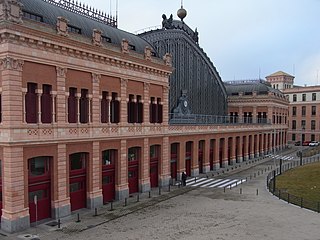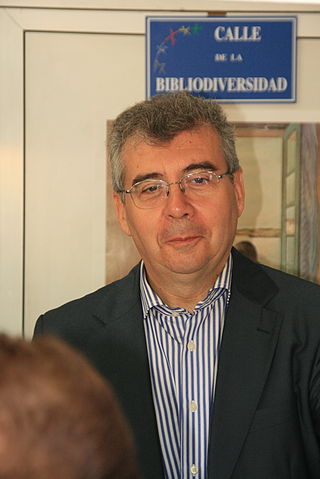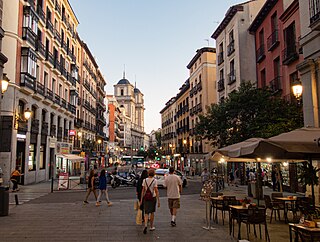
Madrid Atocha, also named Madrid Puerta de Atocha–Almudena Grandes, is the first major railway station in Madrid. It is the largest station serving commuter trains (Cercanías), regional trains from the south and southeast, intercity trains from Navarre, Cádiz and Huelva (Andalusia) and La Rioja, and the AVE high speed trains from Girona, Tarragona and Barcelona (Catalonia), Huesca and Zaragoza (Aragon), Sevilla, Córdoba, Málaga and Granada (Andalusia), Valencia, Castellón and Alicante. These train services are run by Spain's national rail company, Renfe. As of 2019, this station has daily services to Marseille, France.

Cara al Sol is the anthem of the Falange Española de las JONS. The lyrics were written in December 1935 and are usually credited to the leader of the Falange, José Antonio Primo de Rivera. The music was composed by Juan Tellería and Juan R. Buendia.

Paseo de la Castellana, commonly known as La Castellana, is a major thoroughfare in Madrid, Spain. Cutting across the city from South to North, it has been described as the "true structuring axis" of the city.

Acacias or Las Acacias is an administrative neighborhood (barrio) of Madrid belonging to the district of Arganzuela. It has an area of 1.074172 km2 (0.414740 sq mi). As of 1 February 2020, it has a population of 37,049.

Atocha is an administrative neighborhood of Madrid belonging to the district of Arganzuela.

The architecture of Madrid has preserved the look and feel of many of its historic neighbourhoods and streets, even though Madrid possesses a modern infrastructure. Its landmarks include the Royal Palace of Madrid, the Royal Theatre with its restored 1850 Opera House, the Buen Retiro Park, the 19th-century National Library building containing some of Spain's historical archives, a large number of national museums, and the Golden Triangle of Art located along the Paseo del Prado and comprising three art museums: Prado Museum, the Reina Sofía Museum, and the Thyssen-Bornemisza Museum, which completes the shortcomings of the other two museums. Cibeles Palace and Fountain have become the monument symbol of the city.

Manuela Carmena Castrillo is a retired Spanish lawyer and judge who served as Mayor of Madrid from June 2015 to June 2019. She was a member of the General Council of the Judiciary.

Embajadores is an administrative neighborhood (barrio) of Madrid, belonging to the Centro District.

Cuatro Caminos is an administrative neighborhood of Madrid belonging to the district of Tetuán. It has an area of 1.193509 km2 (0.460816 sq mi). As of 1 February 2020, it has a population of 35,395. It was created as slum of the north of the city, on the east side of the Road of France, currently the calle de Bravo Murillo.

The Calle Mayor is a centric street in Madrid, Spain. Located in the Centro District, the Calle Mayor starts in the Puerta del Sol and ends at the cuesta de la Vega.

José Luis Martínez-Almeida Navasqüés is a Spanish state lawyer and politician. A member of the People's Party (PP), he has been a member of the Madrid City Council since 2015 and has been Mayor of Madrid since 2019.

The Bank of Spain Building is the main headquarters of the Bank of Spain. Located in Madrid, it lies at the crossing of the Calle de Alcalá and the Paseo del Prado.

Ifema is an entity charged with the organisation of fairs, halls and congresses in their facilities in Madrid.

Pedro Montoliú Camps is a Spanish journalist who was named a Chronicler of the Villa de Madrid in 1999.

The Calle de Toledo is a historic street in central Madrid, Spain, running across the Centro and Arganzuela districts.

The Calle de San Bernardo is a street in central Madrid, Spain. Located in the Centro and Chamberí districts, it once was the former road in and out of the city from the North.
Carabanchel Bajo was a municipality of Spain, located in the province of Madrid.

The Statue of Lázaro Cárdenas is an instance of public art in Madrid, Spain. Erected at the Parque Norte, it pays homage to Mexican President Lázaro Cárdenas, noted for welcoming into Mexico thousands of Spanish Republican exiles fleeing the Spanish Civil War and the ensuing Francoist dictatorship.

The Monument to Cuba is an instance of public art in Madrid, Spain, consisting of a fountain over which an sculptural group topped by an allegory of Cuba emerges from. It is located at El Retiro Park.

Calle de Preciados, is a public pedestrian street in central Madrid, Spain, which spans from Puerta del Sol to Plaza de Santo Domingo via Plaza de Callao, where it takes a bend. It is about 500-metre long.



















